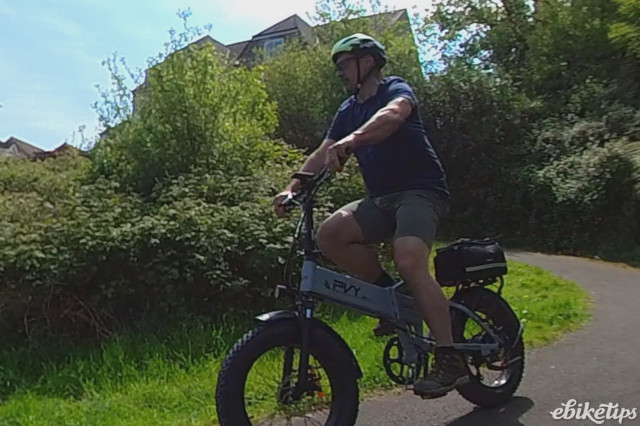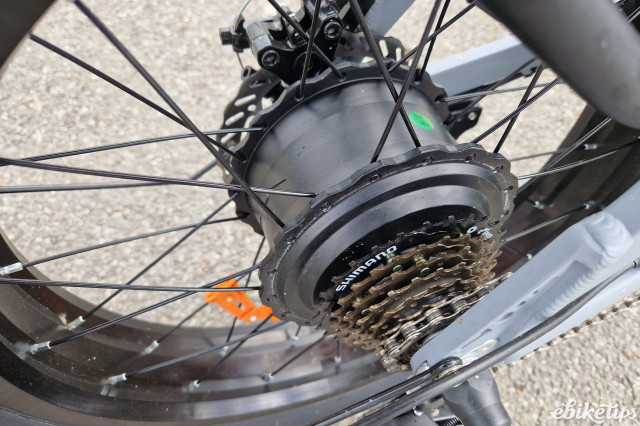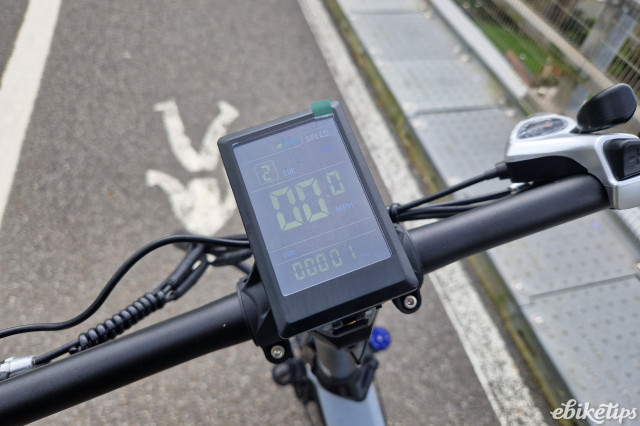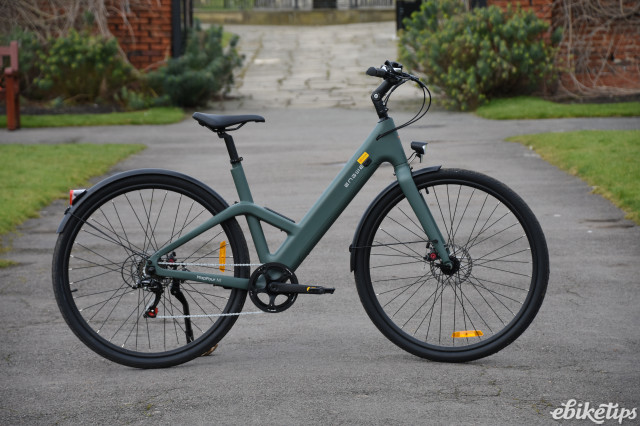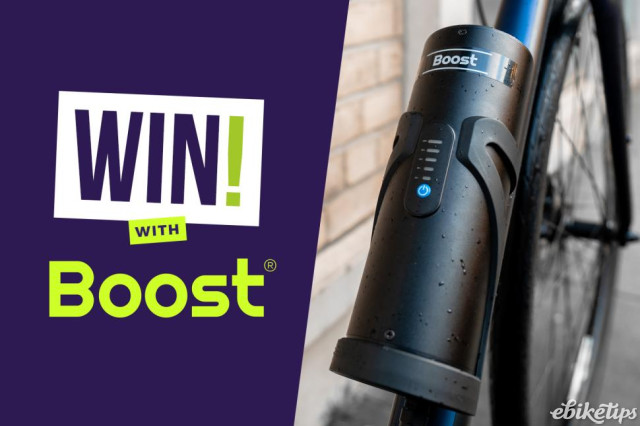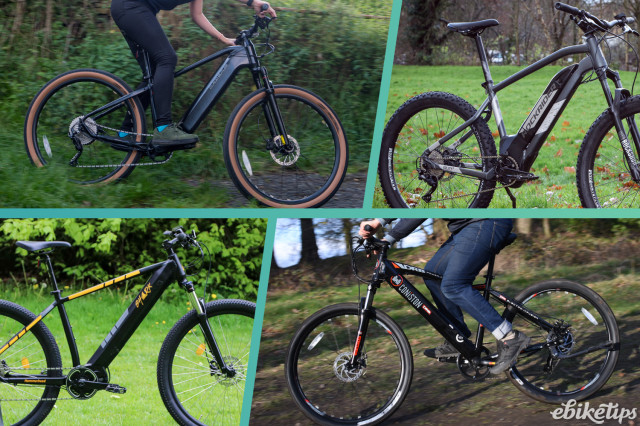Review: PVY Z20 Plus
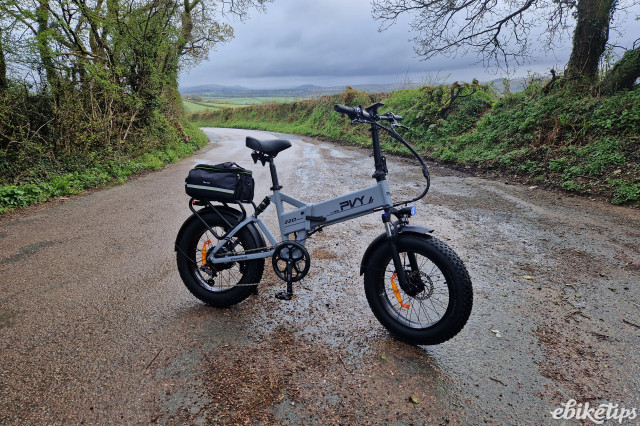
Overview
- Strong motor with good pulling power
- Smooth ride on the road
- Comfortable riding position
- Unrefined pedal assist
- Cumbersome at low speeds
- Not easy to transport when folded
The PVY Z20 Plus is a folding e-bike with fat tyres, a lively motor, and dual suspension. It's an intriguing machine that takes the concept of a folding bike to the extreme, but it's also reasonably priced at under £1,000. I've been using it daily for a few weeks to see if it’s practical for things like shopping and running errands.
After it was delivered, I just about managed to get it downstairs for assembly down a tight stairwell. Putting it together safely will require some basic knowledge of bicycle maintenance, otherwise you should enlist the help of a competent mechanic. The front mudguard, wheel, steerer and seat post need to be fitted and all the bolts torqued up correctly.
At first glance, you wouldn’t think it was a folder until you spot the hinge in the middle of the frame. It’s chunky-looking, and when parked, it attracts curiosity from passers-by. The big tyres dominate its look, making it stand out from regular bikes.
The ride
For my first ride, I threw the PVY in at the deep end with a wet and windy 22-mile jaunt up to the edge of Dartmoor. There are three pedal assist levels, though none are subtle in their power delivery.
In level one, the power kicks in abruptly (after a slight delay) and fades just as quickly. Moving to level two, the pedal assist continues to 11mph, while three will take you to the maximum assisted speed of 15.5mph.
The power isn’t modulated very well — the assist is all or nothing and feels like full power in all three levels (just with different maximum speeds). This makes it difficult for low-speed manoeuvring, and you’ll need to be diligent with the brakes. The 6km/h half-twist throttle compensates for the delay in pedal assist but again lacks modulation. It's either on or off and causes the bike to lurch forwards. (A related model, the Z20 Max, apparently features a torque sensor.)
Once on the move, the Z20 Plus has no problem cruising at 16mph, but trying to pedal beyond that is a chore. For this reason, most riders will choose to leave it in the highest power setting.
The 250W hub motor produces more torque than similar motors I’ve tested — moderate hills don’t faze it much, but steeper hills require more effort. It performed noticeably better on my 25% hill climb test compared to similar e-bikes, but still demanded a concerted effort.
The motor produces a familiar hum, which increases in volume when under load.
I was testing the Plus 500 model, but an even higher-torque Plus 1000 version is available for another £200. That also comes with a larger 792Wh battery versus the 696Wh found on the Plus 500.
Using the highest assist setting rips through the battery power, and I was down to one bar when I got home. I had covered 22 miles with a few hills and a strong headwind. A couple of shopping trips later, the battery died at 25 miles.
The ride is generally relaxed and comfortable, with the exception of the massive saddle. Due to its wide design, it digs into the back of your thighs as you pedal and becomes unpleasant after a few miles. I planned to use the PVY daily for a couple of weeks, so I swapped the saddle out for something more suitable.
Weighing 29kg and with 4-inch tyres, the Z20 Plus feels cumbersome at low speeds. Once you’re at cruising speed, the extra weight becomes less of an issue and the bike handles reasonably well. For riding on the road, the tyre pressures should be around 20 psi - anything much lower, and you’ll feel the back end squirming around.
The front and rear suspension does a decent enough job on the road but doesn’t inspire confidence on anything other than gravel or moderate single-track. The low-speed handling and power delivery also makes it difficult to negotiate anything technical, and the suspension clunks and creaks when you encounter bigger rocks and tree roots.
Folding the PVY isn’t easy due to the weight, and the result is bulky and heavy — you wouldn’t want to take this on and off a train, and I don’t think it would even be allowed on a bus. You would also struggle to fit it in the back of anything other than an estate car or MPV.
There is a built-in handle on the top part of the frame (near the seat tube), but it’s a hefty thing to cart around. Apart from risking a hernia, the non-folding pedals have an appetite for shin flesh.
Specification
The alloy frame looks like it was crafted in the mines of Mordor. There are big welds everywhere, and it looks like it would withstand a fair bit of abuse. The rear end is connected to the main section at two pivot points. A matte grey paint finish adds to the utilitarian look of the bike.
As stated above, the 48V 250W rear hub motor produces plenty of torque, but how the power is delivered is unrefined and counterintuitive.
The colour display is nice enough, although it’s difficult to read in direct sunlight (not that it saw much). All the usual data is available - speed, battery, trip etc.
The battery is housed within the main frame section and can be removed by folding the bike in half. This requires practice, as you need to support the bike with your knees while trying to slide the battery out. Many people will find it easier to charge the battery in situ. The real-world range will be between 25-35 miles depending on rider weight, road and weather conditions. I’m 105kg and managed 25 miles on a hilly route in windy weather.
The gearing is a 7-speed Shimano derailleur and shifter, with a 14-28 freewheel and 52t chainring. Due to the motor power, I only needed to downshift on the steeper hills. You shouldn’t need to come out of top gear on flatter terrain, as the gearing is quite low. Pedal beyond the motor cut-off point when riding downhill, and you’ll spin out at around 17-18mph.
Mechanical disc brakes with 160mm rotors provide stopping power. These worked better than expected throughout the wet testing period but were noisy. Another thing to mention is that they are set up for the EU market, so the front is left, and the rear is right. The levers have cut-off sensors which is important considering the nature of the pedal assist.
The suspension is unrefined with the rear shock being soft and bouncy. The front fork can be locked out if required and does have some preload adjustment. It's fine for light off-road duties and hopping off the kerb, but don't venture too far off the beaten track.
The spoked wheels have held up well over the weeks, and the 20” x 4” tyres seem fairly durable with decent grip in the wet. I had no issues with losing traction or punctures.
Accessories include metal mudguards, front and rear lights, a brake light, and even rear indicators. There’s also an electric horn, a kickstand, and a pannier rack with a 50kg weight capacity.
Comfort and sizing
Apart from the saddle, I found the riding position comfortable. There is plenty of adjustment in the seat and handlebar height. The big tyres and suspension smooth out the ride, and you won’t need to worry about potholes and sunken drain covers as much. My friend, who is 5ft 7in, took the PVY for a 15-mile ride and had no complaints about sizing or saddle comfort.
The recommended heights are 5ft 4in to 6ft 5in, which seems reasonable given the available adjustment. During my time with the Z20 Plus, teenagers and adults of various heights have ridden the bike, and all have been able to adjust it to suit their build.
Alternatives
The PVY Z20 Plus is competitively priced at £949 and it’s quite a lot of bike for your money. There are a few similar alternatives available around this price point.
Engwe’s Engine X costs £1,049 and has a similar set-up: dual suspension, mechanical disc brakes, a 48V motor, and a 624Wh battery. The Engwe is a few kilos heavier.
The Mycle Charge is priced at £1,299 and comes from a UK-based brand that assembles its bikes in Gloucestershire. The Charge uses a 374Wh battery with front suspension but weighs three kilos less.
The Ado A20F is a very popular model in the UK, costing £899. It features a 36V 250W motor, a 374Wh battery, and a front suspension fork.
Conclusion
The PVY Z20 Plus offers a blend of comfort and performance but also pushes the envelope of what a folding bike can be. It also highlights the practical limitations of integrating such heft into a design traditionally valued for portability.
Despite its cumbersome nature at lower speeds and the on/off nature of the power delivery, the Z20 Plus is fun to ride and provides an effortless way to get from A to B.
1 comments
"What I've learned about owning a budget ebike"
"I've a similar "out of the box" set-up, same for a few of my friends they're far from perfect unless you get into the controller settings....not for anything illegal before anyone says anything. There's a group of settings for power level, help intensity and assistance type IE: 3 power levels like mentioned or 5/9 assistance levels (controller type dependent). Undercurrent voltage (at what voltage your bike turns off to prevent battery damage) usually isn't set up right either if you're able to alter this to a suitable safe level do so, changing your crank arms might help with top speed peddling. I'm short so the standard 190mm doesn't allow for acceleration I opted for 140mm paired with a 44t ring. EU brake set-up? Swap it over after all the effort your left with a decent ride 700 miles still going 💪








